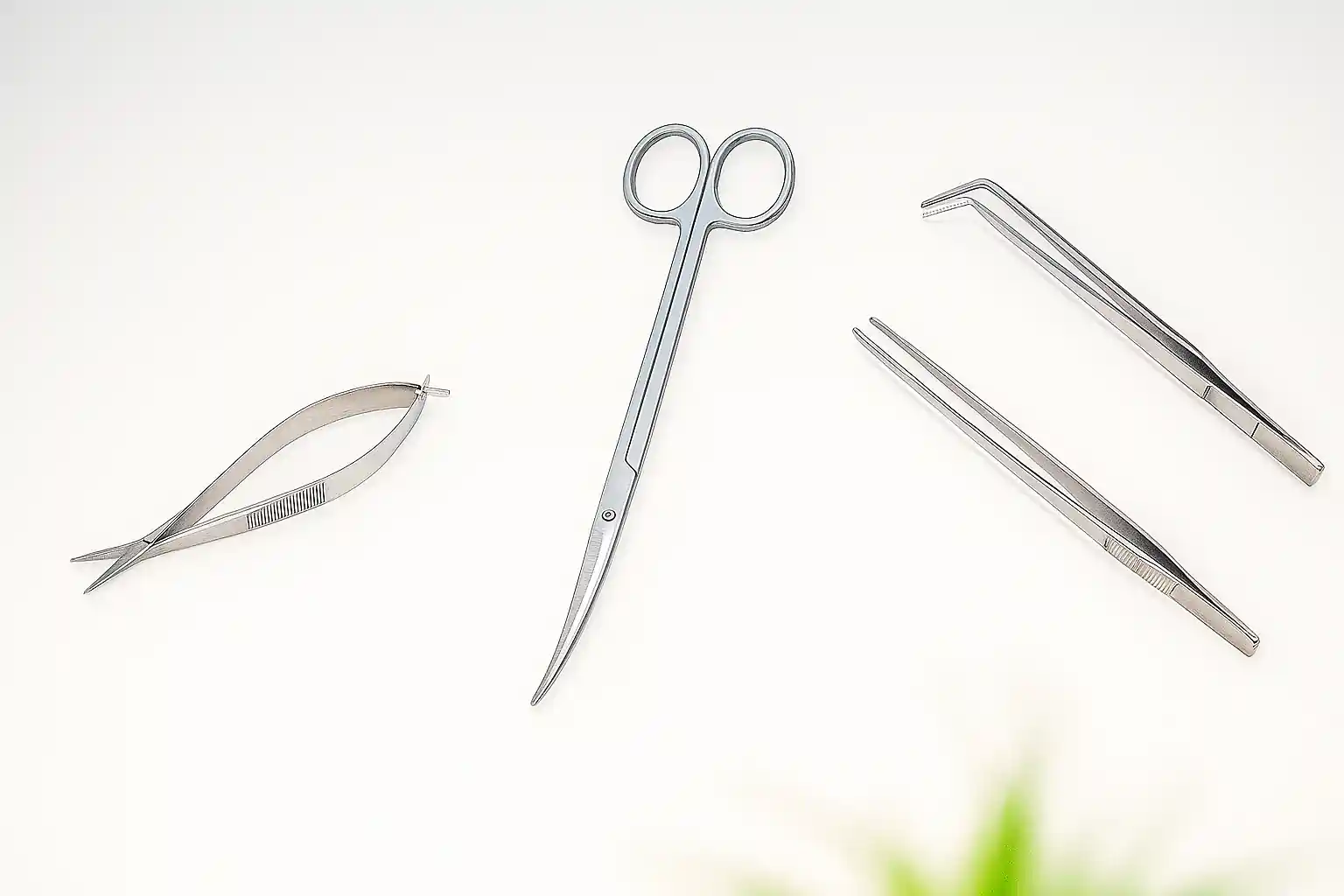
Aquarium Plant Tools Guide for Care and Maintenance
Introduction
Maintaining a thriving planted aquarium requires more than just healthy plants and good lighting — it demands the right set of tools. From delicate planting tweezers to CO₂ diffusers and algae scrapers, aquarium plant tools play a key role in shaping, maintaining, and improving your aquascape. Whether you’re just starting out or already an aquascaping enthusiast, understanding which tools matter most can drastically improve plant health and visual appeal.
In this comprehensive guide, we’ll cover essential equipment, pro tips, and smart organization strategies — all tailored for aquarium and aquascaping hobbyists who want both beauty and efficiency.
What You’ll Learn
- Which aquarium plant tools are essential for planting, trimming, and maintenance
- Key differences between beginner kits and pro tools
- How to choose, clean, and organize tools
- Budget vs premium tool comparisons
- CO₂ tools, algae removers, fertilizer injectors, and more
- A complete checklist based on your aquarium size
Choosing the Right Plant Care Setup
Every aquarist has different needs — the best aquarium plant tools for you depend on your tank size, aquascaping goals, and budget. It’s important to understand your plant care workflow before investing.
Starter Kits vs Advanced Toolsets
Starter kits usually include:
- Straight and curved tweezers
- Small trimming scissors
- Basic algae scraper
They’re affordable, accessible, and perfect for beginners or small tanks. However, they often lack durability and precision.
Advanced toolsets offer:
- Specialized scissors (wave, spring, curved)
- Titanium or stainless steel tools
- CO₂ drop checkers and injector accessories
- Multi-head scraper systems
- Magnetic storage and protective pouches
These are ideal for hobbyists with medium to large aquariums or intricate hardscape setups.
💡 Tip: Invest in quality tools if you plan to maintain a planted tank long-term — they offer better ergonomics, accuracy, and lifespan.
Essential Tools for Planting & Trimming
Healthy plant growth starts with careful planting and regular trimming. These tools ensure you can handle even delicate stems without damaging roots or breaking leaves.
Tweezers (Straight, Curved, Wave)
Tweezers are used to insert plants deep into the substrate without floating away. There are three main types:
- Straight tweezers: Ideal for vertical planting and stem plants.
- Curved tweezers: Better for angling root systems or planting near hardscape.
- Wave tweezers: Designed for maximum precision with carpeting plants like Eleocharis or Monte Carlo.
Look for tweezers with non-slip tips and spring tension that matches your hand comfort.
Scissors & Shears (Spring, Curved, Straight)
Trimming is essential for plant shape, growth stimulation, and preventing algae buildup. Common types include:
- Straight scissors: General-purpose trimming
- Curved scissors: For shaping foreground and midground plants
- Spring scissors: Ideal for precision work in tight areas
- Wave shears: Great for trimming carpets evenly
💡 Pro tip: Trim stem plants at a diagonal to encourage bushier regrowth.
Tools for Hardscape & Substrate Work
Shaping the foundation of your aquascape is easier with the right substrate tools. They help in creating slopes, leveling soil, and avoiding root damage.
Substrate Spatulas & Rakes
These tools are used to level aquarium soil, distribute gravel evenly, and shape elevations.
- Flat spatulas: Best for smoothing out topsoil and sand
- Rakes: Ideal for forming terrain in nature or diorama layouts
Some tools combine both spatula and rake heads for flexibility.
Injector Probes & Pill Tools
Professional aquascapers sometimes use probes or pill tools to:
- Add root tabs into substrate
- Insert slow-release fertilizer pellets
- Create small holes without disturbing the surface layer
These tools make nutrient application precise and mess-free.
🛠️ DIY Hack: A cut-down syringe can substitute for a substrate injector.
Tools for Algae & Glass Maintenance
Clean glass equals a better-looking tank — and fewer algae problems. These tools help remove buildup without scratching.
Scrapers (Magnetic, Plastic, Credit-card DIY)
- Magnetic scrapers: Useful for glass aquariums; can be cleaned from outside.
- Plastic blade scrapers: Remove tough algae without damaging acrylic tanks.
- DIY tools: Old credit cards make excellent mini scrapers for tight corners.
Always check that the blade material matches your tank type (glass or acrylic).
Algae Brushes & Pads
These are ideal for spot cleaning, especially near substrate lines or on hardscape.
- Nylon brushes: Work well for driftwood and rocks.
- Melamine pads: Remove biofilm gently without chemicals.
⚠️ Never use household sponges — they can contain soap or additives toxic to fish.
Nutrient & Fertilizer Tools
Proper nutrient delivery tools ensure your plants get what they need, when they need it.
Liquid Dropper Pipettes
Used to apply:
- Liquid fertilizers (micros and macros)
- Iron supplements
- Liquid carbon (e.g., Excel)
Dropper pipettes offer exact measurements and avoid over-fertilization.
Root Tabs & Fertilizer Injector Tools
Root tabs are inserted beneath heavy root feeders like Amazon swords or Cryptocoryne.
- Root tab forceps: Push tablets deep into substrate
- Injector syringes: Administer liquid root fertilizers below the surface
📌 Reminder: Don’t mix tools used for fertilizers with those for trimming to avoid contamination.
CO₂ & Gas Metering Tools
CO₂ plays a pivotal role in plant health. Using the right tools ensures consistent delivery and monitoring.
CO₂ Diffusers & Drop Checkers
- Glass diffusers: Dissolve CO₂ into fine mist for better absorption
- Inline diffusers: Installed on canister filters for high-tech setups
- Drop checkers: Display CO₂ saturation using color-changing solutions
Bubble Counters & Solenoid Valves
- Bubble counters: Measure CO₂ flow in bubbles-per-second
- Solenoid valves: Automate CO₂ injection using a timer
- Check valves: Prevent water from flowing back into the regulator
🧪 Always calibrate your drop checker with KH solution for accuracy.
Budget vs Premium Tools Comparison
The price difference between budget and premium tools often reflects material, precision, and durability.
| Feature | Budget Tools | Premium Tools |
|---|---|---|
| Material | Plastic or low-grade steel | Stainless steel or titanium |
| Precision | Moderate | High |
| Longevity | 6–12 months | Several years |
| Ergonomics | Basic handles | Designed for comfort |
| Cost | $5–$15 | $20–$80+ |
💡 Premium tools are a wise investment for long-term aquascapers or those with large tanks.
Tool Material Guide: Stainless vs Titanium vs Plastic
Choosing the right material enhances tool performance and safety.
- Stainless Steel: Common in mid- to high-range tools; rust-resistant with proper care.
- Titanium: Lightweight, strong, and highly corrosion-resistant; often used in top-tier tools.
- Plastic: Suitable for beginners, but prone to warping and cracking over time.
⚙️ Clean metal tools with distilled water and dry thoroughly to prevent rust.
Tool Care & Maintenance
Proper care extends the lifespan and precision of your aquarium plant tools.
Sterilization (Bleach, Algae)
- Soak tools in a 1:20 bleach solution for 10 minutes
- Rinse thoroughly and dry
- Sterilize after trimming infected or algae-covered plants
Sharpening & Lubrication
- Use sharpening stones for scissors and shears
- Apply mineral oil to hinges and blades
- Store tools in a dry place, ideally in a tool roll or case
🧼 Always rinse tools after use to remove plant sap and substrate residues.
Tool Kit Checklist by Tank Size
A properly scaled tool kit makes maintenance easier and more effective.
Nano Tanks (<20 L)
- Small curved tweezers
- Spring scissors
- Compact scraper
- Pipette for dosing
- Foldable towel
Medium Tanks (20–100 L)
- Full-size tweezers (straight and curved)
- Curved shears
- Magnetic scraper
- Gravel vacuum
- Substrate spatula
Large Tanks (>100 L)
- Long tweezers and shears (30–45 cm)
- CO₂ monitoring kit
- Large gravel siphon
- Bucket and jug set
- Tool organizer tray
DIY Tool Hacks
- Old toothbrush → Algae scrubber
- Credit card edge → Glass scraper
- Cooking tongs → Temporary plant tweezer
- Dropper bottle → DIY liquid fertilizer doser
💡 Get creative! Many household items can be temporarily repurposed.
Tool Organization & Storage
Keeping tools clean and accessible improves efficiency.
- Magnetic strips mounted inside cabinet doors
- Tool rolls or pouches for transport and protection
- Drawer organizers for hobby stations
- Tool trays for easy access during trimming
Quick Takeaways
- Use specialized aquarium plant tools for precision and safety
- Choose tool materials based on budget and corrosion resistance
- Match your tool size to your tank’s dimensions
- Clean and store tools properly to extend their life
- DIY tools can be effective in a pinch but are not a long-term solution
Conclusion
Whether you’re just starting out or refining your aquascape, having the right aquarium plant tools makes a dramatic difference. From simple tweezers to advanced CO₂ systems, investing in quality tools and maintaining them properly ensures healthier plants, cleaner tanks, and a smoother experience overall. With this guide, you’re now equipped to trim, plant, clean, and dose like a pro.
💬 Join the Conversation
Tag and write us on Instagram @AquariumLesson — we’d love to see your setup and the tools you use!
👉 What’s your favorite aquarium tool you can’t live without?
FAQ
Do I really need special tools for aquarium plants?
Yes. Aquarium plant tools offer precision and protect delicate plants during planting and trimming.
Can I use kitchen scissors or tweezers?
They may work short-term, but can rust or damage plants. Aquarium plant tools are rust-proof and ergonomically designed.
How often should I clean my tools?
After every use if possible. At minimum, disinfect weekly or after trimming infected plants.
Are titanium tools worth the cost?
If you’re serious about aquascaping or own a large tank, yes. They’re lightweight, corrosion-resistant, and long-lasting.
How do I sharpen dull plant scissors?
Use a fine whetstone or professional sharpener. Always clean the blade first.
References
- Aquascaping Tool Guide – 2Hr Aquarist https://www.2hraquarist.com/
Comprehensive breakdown of scissors, tweezers, and setup strategies. - Tropica Aquarium Tools – Tropica.com https://tropica.com/en/guide
Official overview of recommended tools and plant care practices. - Aquarium Tool Reviews – Aquasabi Blog https://www.aquasabi.com/blog
User-based reviews and comparisons of top tool brands. - CO₂ System Setup Guide – Green Aqua https://www.greenaqua.hu
Integration of tools with CO₂ systems.
Inspire someone – share this post
